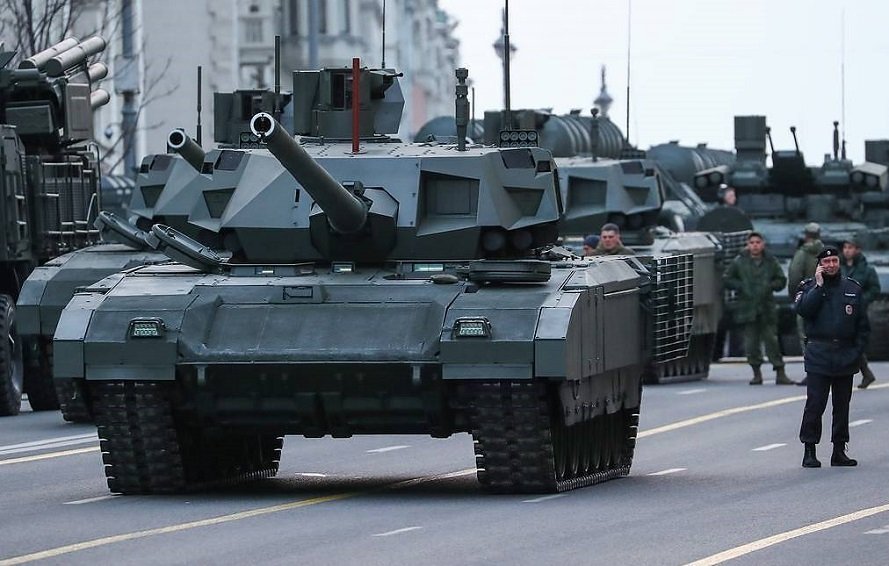
Armoured Vehicle – Weekly Review
 According to a statement released on April 13, 2020, by the Russian MOD press service, the first T-90M Proryv Main Battle Tanks (MBTs) have been delivered to the 1st Guards Tank Army of Western Military District deployed in five regions of Russia.
According to a statement released on April 13, 2020, by the Russian MOD press service, the first T-90M Proryv Main Battle Tanks (MBTs) have been delivered to the 1st Guards Tank Army of Western Military District deployed in five regions of Russia.
The T-90M model 2017 also nicknamed Proryv-3 is an upgraded variant of the export version of the T-90MS Main Battle Tank (MBT) developed and designed by the Russian Company Uralvagonzavod.
Asian Military Rewiev magazine reported Indonesian Navy Korps Marinir (KORMAR) is eyeing a second batch of up to 79 Russian BT-3F tracked amphibious infantry fighting vehicles (IFVs) worth up to $289 million. KORMAR is already operating 21 BT-3F APCs, which are derived from the BMP-3 IFV, acquired at a cost of $67.2 million from state-owned defence exporter JSC Rosoboronexport in April 2019. Indonesia is also the first international customer of the BT-3F.
Russian company Uraltransmash (a subsidiary of the Rostec corporation’s Uralvagonzavod) has delivered the first modernised 2S7M Malka self-propelled heavy artillery canon to the Defence Ministry on April 13. The weapon is considered to be one of the most powerful in the world. The modernised artillery canon has received new running gear and electronics, which has significantly improved its tactical and technical features. Malka has passed a full cycle of tests, aimed at checking its mobility, resistance, loading and reliability of its fire control mechanisms, and 2A44 gun strength.
General Dynamics European Land Systems has been awarded a contract by the German procurement agency BAAINBw for the delivery of 80 highly protected EAGLE 6×6 vehicles for the German Army`s ambulance corps. First vehicle deliveries will start in 2021 and continue throughout 2024.
The EAGLE was selected in a competitive tender process under the medium protected ambulance vehicle program (“mittleres geschütztes Ambulanzfahrzeug”), which will close the gap between the user´s light and heavy ambulance vehicle fleet. Germany is the 2nd customer for this new EAGLE version after the Swiss Army.
Kongsberg Defense & Aerospace has received a contract under the US Foreign Military Sales (FMS) program for delivery of the Kongsberg Protector Remote Weapon Station (RWS) to Lithuanian Armed Forces as part of a total package worth $170.8 million USD. This is the first contract between Kongsberg Defense and the Lithuanian Government under FMS.
UK Armed Forces have ordered four Rheinmetall Mission Master robotic vehicles. Configured for transporting cargo, these unmanned ground vehicles will form part of the United Kingdom’s Robotic Platoon Vehicle programme.
This programme is designed to determine the extent to which unmanned vehicles can boost the combat effectiveness and capabilities of dismounted troops at platoon level. The four Mission Master – Cargo vehicles will be delivered throughout the spring of 2020.
The China North Industries Corporation‘s (Norinco’s) Sharp Claw I unmanned ground vehicle (UGV) has entered service with the People’s Liberation Army Ground Force (PLAGF). In an announcement made on 13 April via its Sina Weibo account the PLA’s Eastern Theatre Command confirmed. No information was provided as to when exactly it entered service, the number of platforms being acquired, or which PLAGF units will deploy it. UGV weighs 120 kg, is 60 cm high, 70 cm long, and has an operational range of 1 km (Janes).
South Korean company Kia Motors Corporation has won a tender for the supply of thousands of 2.5- and 5-tonne trucks to replace the Republic of Korea Army’s (RoKA’s) in-service KM250 and KM500 vehicles. Company officials told Jane’s on 17 April that the company had emerged as the preferred bidder – over rival local company Hanwha Defense – in November 2019 with its 4×4 ‘Medium Standard Vehicle’ and 6×6 ‘5-tonne Bulletproof Kit Vehicle’, the latter of which also comes in an armoured variant. The following month Kia signed a contract with the RoKA for the mass production of 7,000 units of the 2.5-tonne truck and 3,400 units of the 5-tonne platform from 2024 for KRW1.7 trillion (USD1.4 billion) once development of the platforms has been completed. In addition, the company said it will manufacture 600 units of the armoured variant of the 5-tonne truck along with several other special variants of both vehicles. 
The Mykolayiv Armored Plant state enterprise, which is part of the Ukroboronprom Consern, has transferred to the Ministry of Defense of Ukraine a batch of eight heavily upgraded armored reconnaissance vehicles BRDM-2L1. This is the first batch of hardware that underwent a major overhaul and performance upgrade at Mykolayiv Armored Plant as part of the current state defense order.
During the overhaul, taking into account combat experience of the Ukrainian military, the enterprise’s experts enhanced capabilities of the BRDM-2 base vehicle. In particular, the BRDM-2L1 now boasts the latest navigation and communication tools, a thermal imaging night control system; more efficient personnel seating, and better ergonomics due to side hatches with reinforced armor, which shortens landing time and simplifies operation.
 British Company Supacat in collaboration with DEW Engineering and Development (DEW) of Canada, will offer the new HMT Extenda Mk2 Special Forces vehicle for the NGFV (Next Generation Fighting Vehicles) program for the Canadian armed forces. Armyrecognition reported, in July 2019, the Canadian Department of National Defence (DND) announced the intention to procure approximately 55 to 75 Next Generation Fighting Vehicles (NGFV) to replace the existing High Mobility Multipurpose Wheeled Vehicles (HMMWV). The HMMWV is used by the Canadian Special Operations Forces Command (CANSOFCOM) for expeditionary operations.
British Company Supacat in collaboration with DEW Engineering and Development (DEW) of Canada, will offer the new HMT Extenda Mk2 Special Forces vehicle for the NGFV (Next Generation Fighting Vehicles) program for the Canadian armed forces. Armyrecognition reported, in July 2019, the Canadian Department of National Defence (DND) announced the intention to procure approximately 55 to 75 Next Generation Fighting Vehicles (NGFV) to replace the existing High Mobility Multipurpose Wheeled Vehicles (HMMWV). The HMMWV is used by the Canadian Special Operations Forces Command (CANSOFCOM) for expeditionary operations.
DEW is the largest manufacturer of composite armour in North America, supplying armour to General Dynamics Land Systems and General Dynamics Land Systems – Canada for all US Army Stryker vehicles, RG31 Mine Resistant Ambush Protected (MRAP) vehicles, and other international customers.
The International Armored Group (IAG) company presented is new modified COVID-19 Ambulances in April 17. The IAG COVID-19 Ambulances have been customized to include special medical equipment for COVID-19 such as portable ventilator and suction units, patient isolation pods, automatic resuscitator system with extra oxygen supply tanks, advanced vitals’ monitor units, defibrillators, built-in disinfecting system and ample personal protective equipment (PPE) with extra storage. These ambulances also have the rear patient section of the vehicle sealed off to keep the drivers safe from exposure, as well as other specialty features to help deal with highly infectious diseases.
The COVID-19 Ambulances are available on various vehicle chassis in both LHD and RHD such as Ford F550, Ford Transit, GMC Savana, Chevy Express, Toyota Hiace, Toyota Land Cruiser 78, 200, Nissan Urvan, Mercedes Sprinter and more. These specialty ambulances will be offered in non-armored versions, however armored versions will be available upon request.
On April 17, 2020, the U.S. Department of Defense (DoD) has announced that BAE Systems Land & Armaments, was awarded a $14,069,872 to contract for engineering and manufacturing development portion of the Armored Multi-Purpose Vehicle (AMPV). The AMPV is the U.S. Army’s program to replace the Vietnam War-era and legacy M113 Family of Vehicles. 
Russian Minister of Industry and Trade Denis Manturov said on Sunday, T-14 tank on the heavy tracked vehicle platform has been tested in Syria, Russian Minister of Industry and Trade Denis Manturov said on Sunday.
“Yes, that’s right. They [Armata tanks] were used in Syria,” he said in an interview with the Deistvuyushchiye Litsa (Political Actors) with Nailya Asker-zade program on the Rossiya-1 television channel answering a corresponding question. “They were used in field conditions, in Syria, so, we took into account all the nuances.”
“The T-14 Armata tank is expensive because it is still undergoing extra trials and modernization after the defense ministry requested additional technical solutions in order to begin serial supplies starting from the next year under the existing contract,” said Denis Manturov.
The Armata is a heavy tracked standardized platform serving as the basis to develop a main battle tank, an infantry fighting vehicle, an armored personnel carrier and some other armored vehicles. The T-14 tank based on the Armata platform was shown to the public for the first time at Red Square’s Victory Day parade on May 9, 2015. The new combat vehicle features fully digitized equipment, an unmanned turret and an isolated armored capsule for the crew. Serial supplies of Russia’s new T-14 tanks on the Armata platform to Russian troops will begin in 2021.
TASS reported, Russia plans to begin work with potential foreign buyers of Russian Armata tanks and has already received a number of advance orders.


